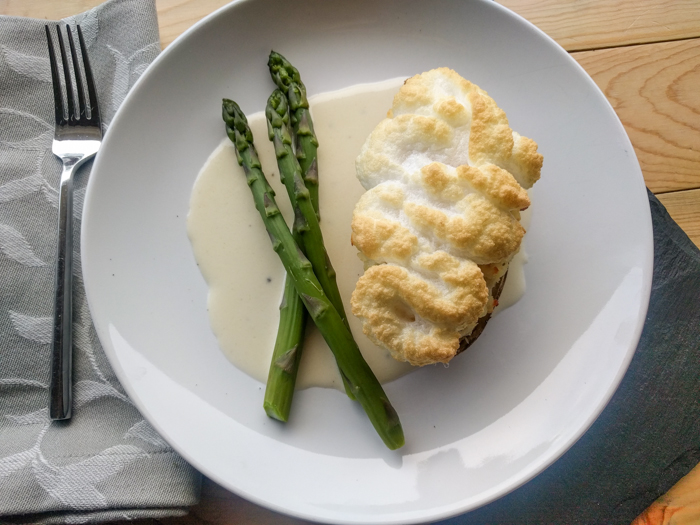 Come fall, we will be leading a private cycling tour in Tuscany, traveling from Arezzo to Montepulciano to Montalcino. My colleague Vernon customizes the routes, so our guests can enjoy those classic Tuscan views on their way to a great winery or our villa hotel. My role is to introduce the local wines, produce and cuisine that make each place we visit unique. Tuscany is known for its meats – the Chianina beef used for Bistecca alla Fiorentina, or the Cinta Senese pigs, but Tuscans have a real passion for vegetables.
Come fall, we will be leading a private cycling tour in Tuscany, traveling from Arezzo to Montepulciano to Montalcino. My colleague Vernon customizes the routes, so our guests can enjoy those classic Tuscan views on their way to a great winery or our villa hotel. My role is to introduce the local wines, produce and cuisine that make each place we visit unique. Tuscany is known for its meats – the Chianina beef used for Bistecca alla Fiorentina, or the Cinta Senese pigs, but Tuscans have a real passion for vegetables.
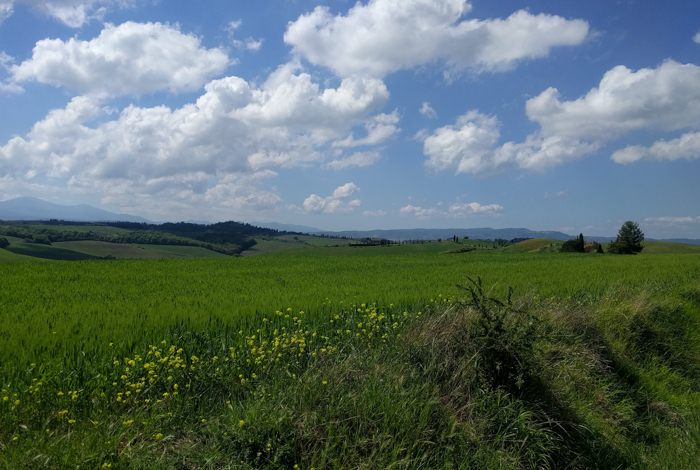 One local specialty that most visitors would not notice is the red potato of Cetica. Just north of our start point in Arezzo, this ancient variety of potato has been cultivated here since the beginning of the last century. They grow at 500 meters above sea level or higher, in loose, sandy soil made nutrient-rich with organic material. These potatoes are small and round with light red skin and the flesh is white with reddish tones. They are excellent when used in gnocchi and potato tortelli, all of them Cetican specialties.
One local specialty that most visitors would not notice is the red potato of Cetica. Just north of our start point in Arezzo, this ancient variety of potato has been cultivated here since the beginning of the last century. They grow at 500 meters above sea level or higher, in loose, sandy soil made nutrient-rich with organic material. These potatoes are small and round with light red skin and the flesh is white with reddish tones. They are excellent when used in gnocchi and potato tortelli, all of them Cetican specialties.
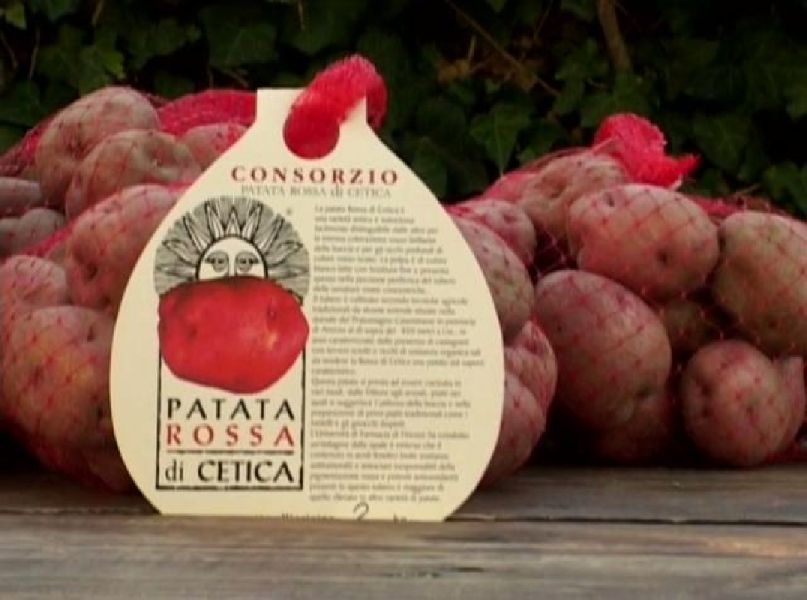 From the book Italy and the Potato: A History, 1550-2000, by David Gentilcore (yes, an entire book on the subject), I found the following anecdote about Prince Umberto of Savoy’s introduction to the local specialty during his visit in 1925: “During his visit the prince was served the local “Cetica” potatoes in different ways… When the prince seemed to have had his fill of the “Cetica” potato, a local chirped up and invited him not to stand on ceremony since there was plenty: ‘Sir prince, eat them and don’t be silly, we have enough for the pigs too’. The story is too good to be true, and probably is not, invented by the townspeople to poke fun at their rural neighbors, the Ceticatti.
From the book Italy and the Potato: A History, 1550-2000, by David Gentilcore (yes, an entire book on the subject), I found the following anecdote about Prince Umberto of Savoy’s introduction to the local specialty during his visit in 1925: “During his visit the prince was served the local “Cetica” potatoes in different ways… When the prince seemed to have had his fill of the “Cetica” potato, a local chirped up and invited him not to stand on ceremony since there was plenty: ‘Sir prince, eat them and don’t be silly, we have enough for the pigs too’. The story is too good to be true, and probably is not, invented by the townspeople to poke fun at their rural neighbors, the Ceticatti.
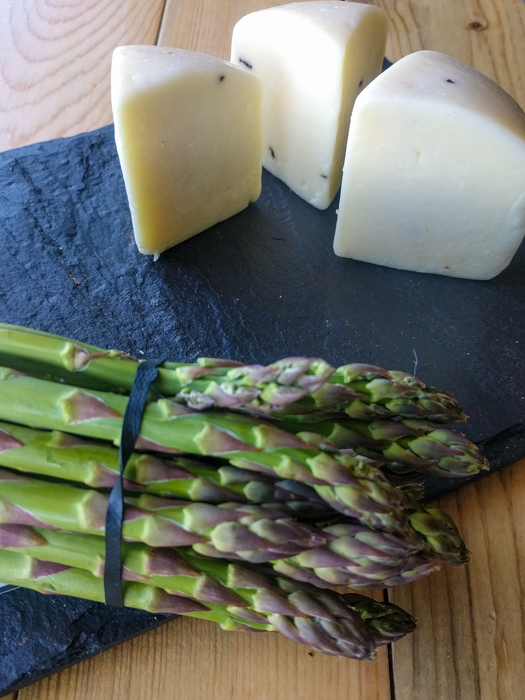 The following recipe, from a regional cookbook put out by the Arezzo area tourist board, may have been one of the many served to the Prince that day. It is similar to our Twice-Baked Potatoes, but the addition of an egg and a truffle cream takes it over the top. They can be prepped in advance up until you top it with the egg yolk and beaten whites, perfect to pair with a roast, or a grilled steak.
The following recipe, from a regional cookbook put out by the Arezzo area tourist board, may have been one of the many served to the Prince that day. It is similar to our Twice-Baked Potatoes, but the addition of an egg and a truffle cream takes it over the top. They can be prepped in advance up until you top it with the egg yolk and beaten whites, perfect to pair with a roast, or a grilled steak.
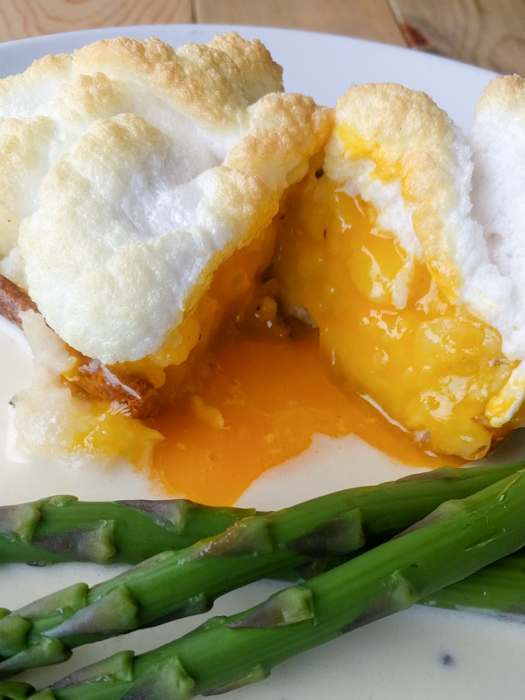 Patate di Cetica su Letto di Asparagi e Fonduta di Pecorino
Patate di Cetica su Letto di Asparagi e Fonduta di Pecorino
Serves 4
For the potatoes:
2 medium size Cetica potatoes (I substituted russet)
4 ounces grated Pecorino cheese
1 tablespoon butter
Kosher salt and freshly ground black pepper
4 eggs, separated
12 green asparagus spears
For the fonduta:
10 ounces of Pecorino Tartufo – pecorino cheese studded with truffles, cut into small cubes
7 ounces fresh heavy cream
2 ounces butter
1/4 cup dry white wine
Kosher salt and freshly ground pepper
Preheat oven to 355°F. Wash the potatoes, place on a sheet pan and sprinkle with kosher salt. Bake until tender, about 45 minutes.
Meanwhile, clean the asparagus by removing the tough part. Blanch in boiling salted water until tender, about 5 minutes. Drain and cool immediately in cold water.
When the potatoes have cooled slightly, slice lengthwise and scoop out the contents without damaging the skin.
Mash the pulp in a bowl using a fork, add the grated cheese and the butter, season with salt and pepper, stirring until the mixture is smooth, then fill the skins, making a small indentation on the top to hold an egg yolk. Bake for 5 minutes at 400°F.
Gently place one yolk on top of each potato, add salt and pepper to taste.
Whisk the egg whites into stiff peaks with a pinch of salt and use a pastry bag, or a plastic bag with a corner cut off to decorate the top of each potato with the beaten egg whites, covering the yolks. Bake until the whites are golden.
For the fondue, melt the butter in a medium saucepan. Add the cubed Pecorino Tartufo, heavy cream, and wine. Cook over low heat, stirring occasionally, until the cheese has melted completely. Season to taste with salt and pepper.
Heat the asparagus. Arrange the asparagus on four plates, drizzle with the fondue and add a potatoes to each.
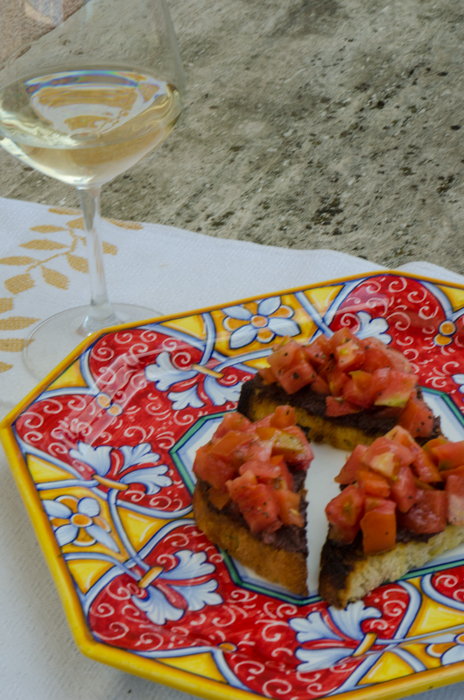 A few years ago I wrote an article here on “
A few years ago I wrote an article here on “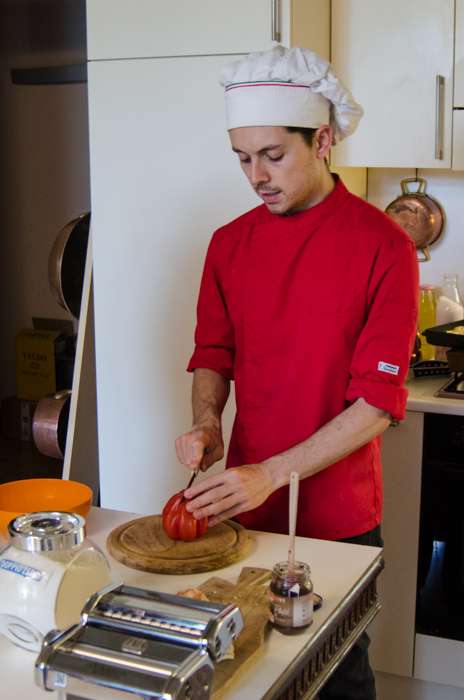 First of all, one of the secrets to the great tomato bruschetta here in Italy is their tomatoes. As early as mid-May I find tasty fresh tomatoes at the market. We have in the US the large Beefsteak tomatoes. In Italy, the equivalent is at the market already, the “Cuore di Bue” or “Heart of Ox” tomato. They are cultivated all over Italy, under different names in the different regions – Pomodoro di Albenga in Liguria, Pera d’Abruzzo in Abruzzo (Pear of Abruzzo). These tomatoes have a characteristic pear-shape, large and irregular with a smooth thin skin. They make a great bruschetta, and other raw tomato dishes, because they have exceptionally fleshy meat, with very few seeds in the pulp – a much more solid consistency than a typical Beefsteak or Heirloom tomato I find here. They also are incredibly tasty.
First of all, one of the secrets to the great tomato bruschetta here in Italy is their tomatoes. As early as mid-May I find tasty fresh tomatoes at the market. We have in the US the large Beefsteak tomatoes. In Italy, the equivalent is at the market already, the “Cuore di Bue” or “Heart of Ox” tomato. They are cultivated all over Italy, under different names in the different regions – Pomodoro di Albenga in Liguria, Pera d’Abruzzo in Abruzzo (Pear of Abruzzo). These tomatoes have a characteristic pear-shape, large and irregular with a smooth thin skin. They make a great bruschetta, and other raw tomato dishes, because they have exceptionally fleshy meat, with very few seeds in the pulp – a much more solid consistency than a typical Beefsteak or Heirloom tomato I find here. They also are incredibly tasty.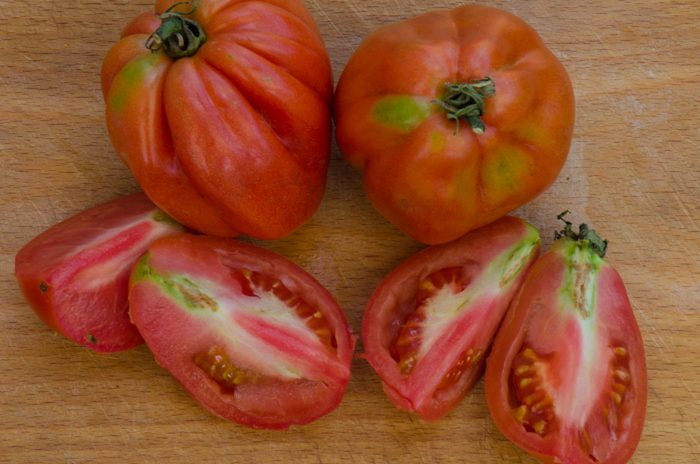 There are many varieties of fruits and vegetables found in Italy that are not cultivated in the US – I see numerous types of radicchio here, white asparagus, artichokes I can eat raw, and these Cuore di Bue tomatoes – which surprises me especially given that tomatoes originally came to Italy from North America! In lieu of Cuore di Bue tomatoes, you can chop up the best eating tomatoes you can find, season them with salt, pepper and oregano as the following recipe instructs, then place the tomatoes in a strainer over a bowl and allow to sit for a couple of hours. The water will slowly drain out, concentrating the tomato flavor.
There are many varieties of fruits and vegetables found in Italy that are not cultivated in the US – I see numerous types of radicchio here, white asparagus, artichokes I can eat raw, and these Cuore di Bue tomatoes – which surprises me especially given that tomatoes originally came to Italy from North America! In lieu of Cuore di Bue tomatoes, you can chop up the best eating tomatoes you can find, season them with salt, pepper and oregano as the following recipe instructs, then place the tomatoes in a strainer over a bowl and allow to sit for a couple of hours. The water will slowly drain out, concentrating the tomato flavor.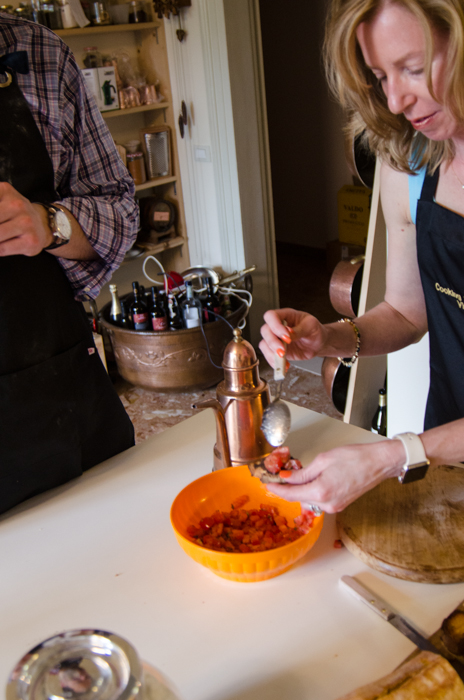 Lucas recommends a good robust bread for bruschetta, something made with harder wheat like semolina, rather than a lighter baguette. I like to use sourdough breads back in the US. He also adds a layer of olive paste, which we all agreed made a great dish even better!
Lucas recommends a good robust bread for bruschetta, something made with harder wheat like semolina, rather than a lighter baguette. I like to use sourdough breads back in the US. He also adds a layer of olive paste, which we all agreed made a great dish even better!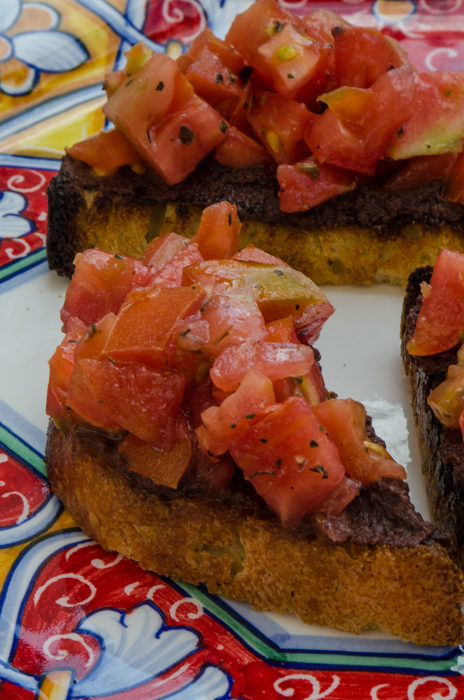
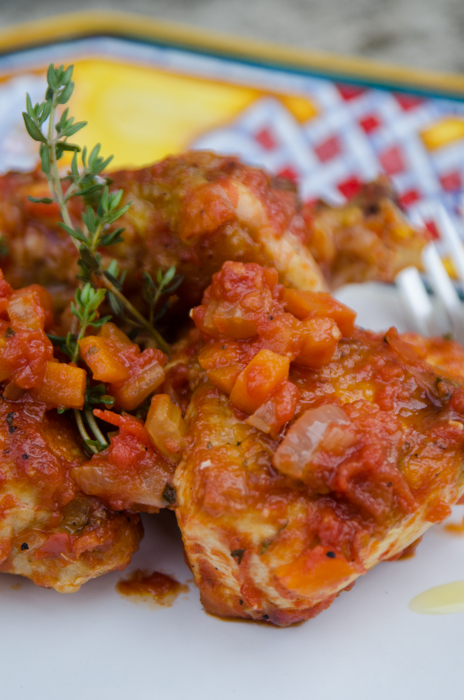 I spent a few days in Tuscany this week, searching out new discoveries for our
I spent a few days in Tuscany this week, searching out new discoveries for our 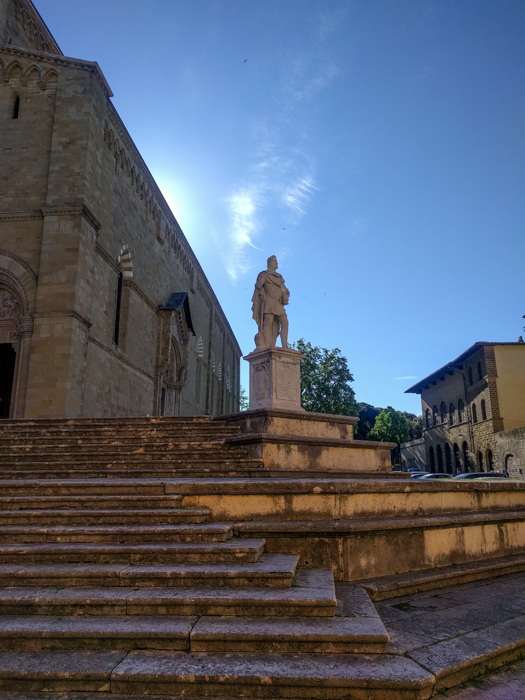
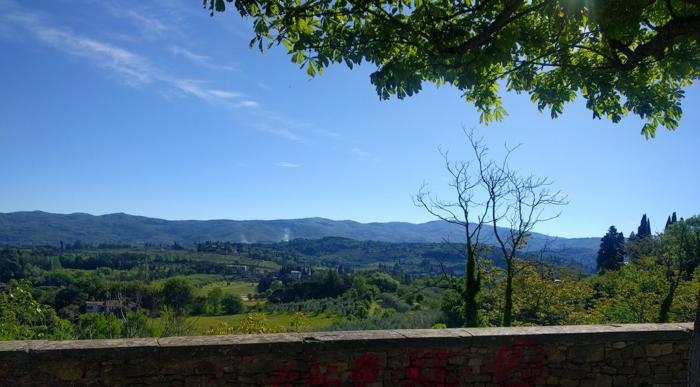
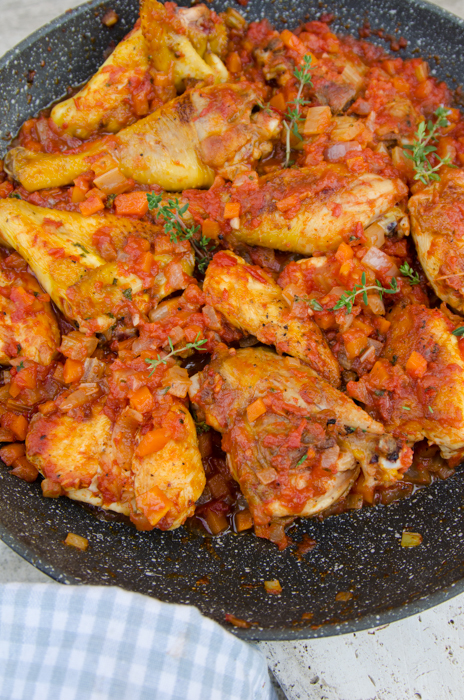 Today’s version of this recipe contains tomatoes, but this is also likely not original, as tomatoes were not found in Italy until they arrived from the New World. The original dish would have used ingredients that could be found in the woods or easily carried in – onions, mushrooms, herbs, and of course, wine. So adding ingredients like peppers, mushrooms, and other herbs would certainly be in keeping with the traditions behind this dish.
Today’s version of this recipe contains tomatoes, but this is also likely not original, as tomatoes were not found in Italy until they arrived from the New World. The original dish would have used ingredients that could be found in the woods or easily carried in – onions, mushrooms, herbs, and of course, wine. So adding ingredients like peppers, mushrooms, and other herbs would certainly be in keeping with the traditions behind this dish.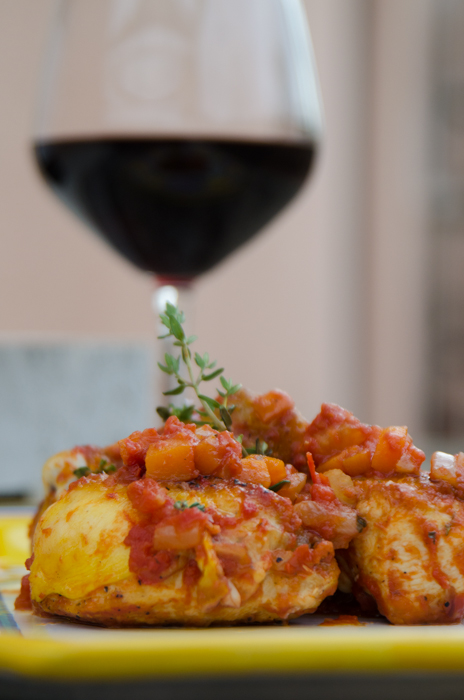 Pollo alla Cacciatora – Chicken Cacciatora
Pollo alla Cacciatora – Chicken Cacciatora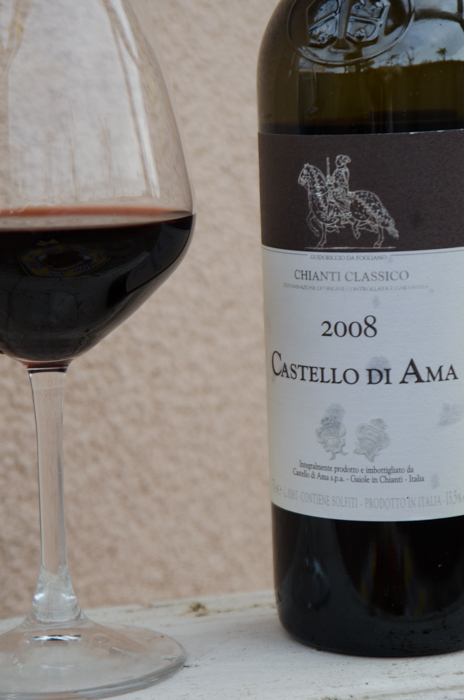
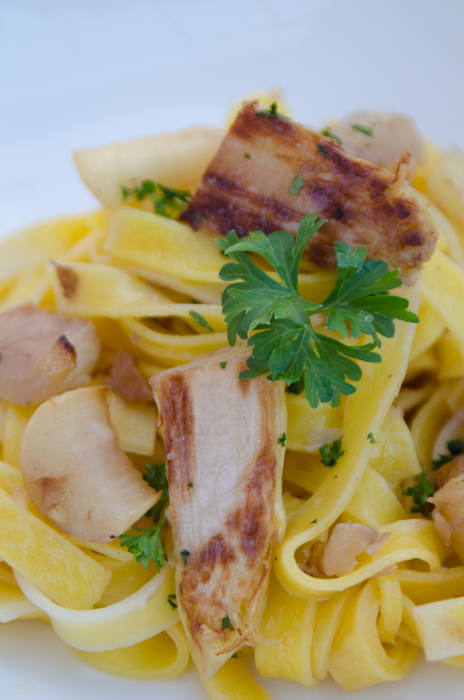 On our April
On our April 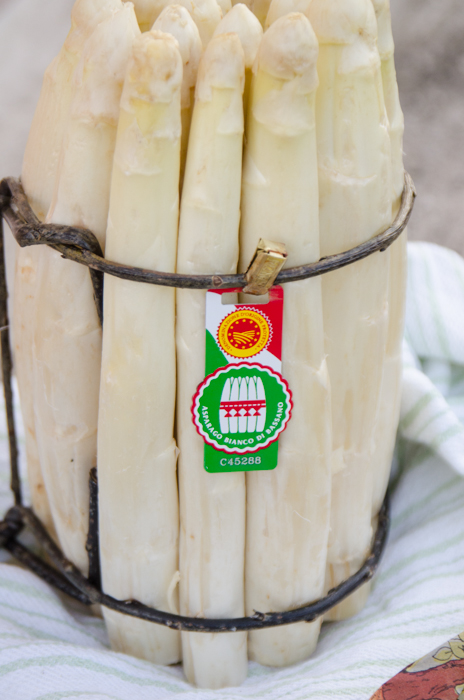 More recently, Ernest Hemingway, during his stint as a volunteer in the Red Cross of the United States during the First World War, so enjoyed the taste of an asparagus dish that he celebrated the plant in his legendary book, Farewell to Arms.
More recently, Ernest Hemingway, during his stint as a volunteer in the Red Cross of the United States during the First World War, so enjoyed the taste of an asparagus dish that he celebrated the plant in his legendary book, Farewell to Arms.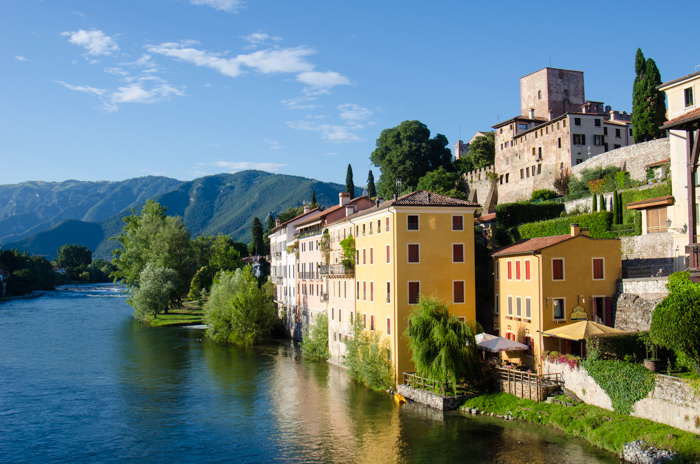 During our week, we enjoyed an asparagus risotto on our first night. Later in the week, we visited a winery with a farm-to-table restaurant that produces their own asparagus. Our antipasti selection included roasted white asparagus with polenta and sopressa. Our primi was a tasting of two pasta dishes – we couldn’t make up our minds! Another asparagus risotto, and a pasta carbonara with white asparagus and poppy seeds, made with eggs from their own geese.
During our week, we enjoyed an asparagus risotto on our first night. Later in the week, we visited a winery with a farm-to-table restaurant that produces their own asparagus. Our antipasti selection included roasted white asparagus with polenta and sopressa. Our primi was a tasting of two pasta dishes – we couldn’t make up our minds! Another asparagus risotto, and a pasta carbonara with white asparagus and poppy seeds, made with eggs from their own geese.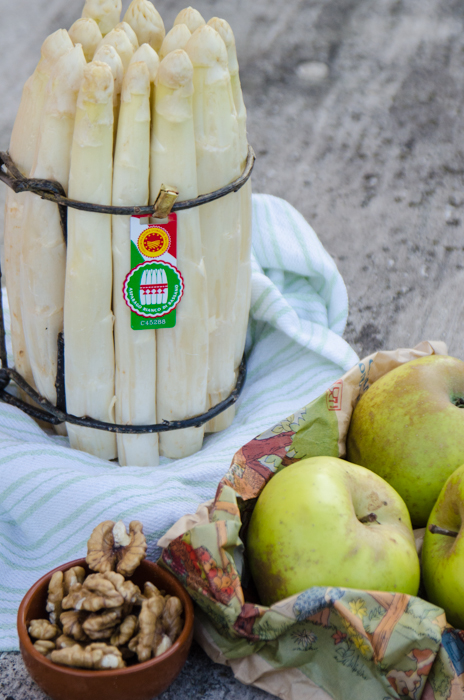
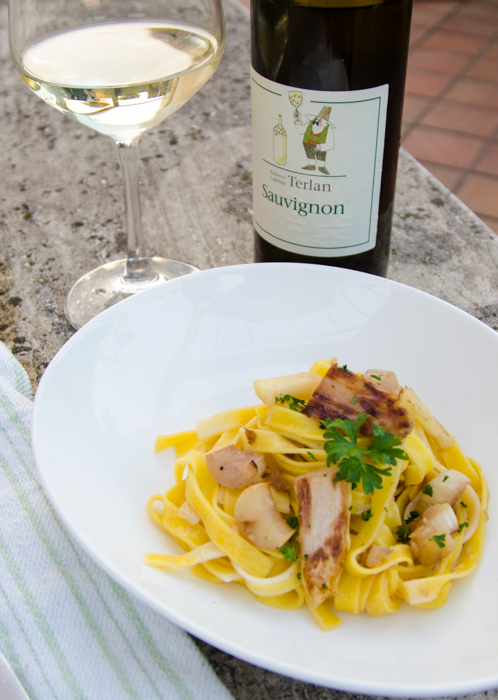
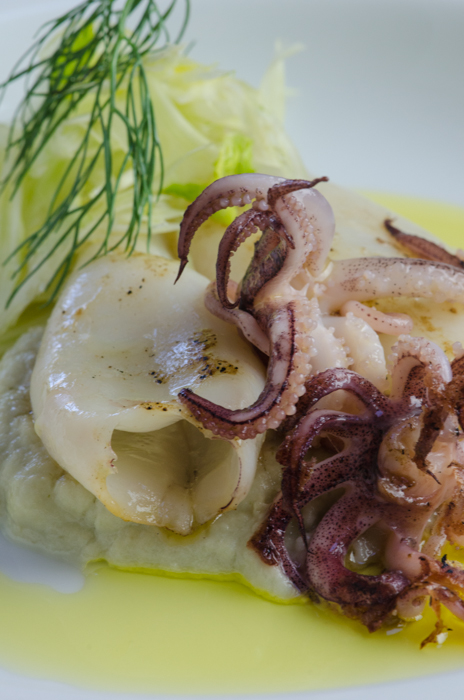 Our
Our 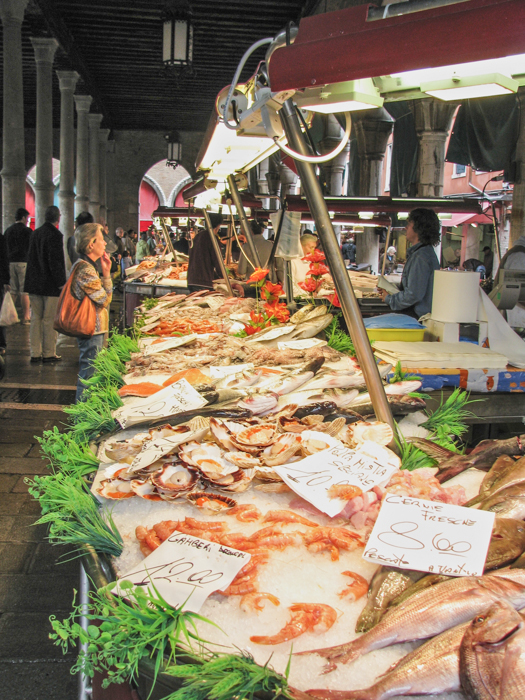
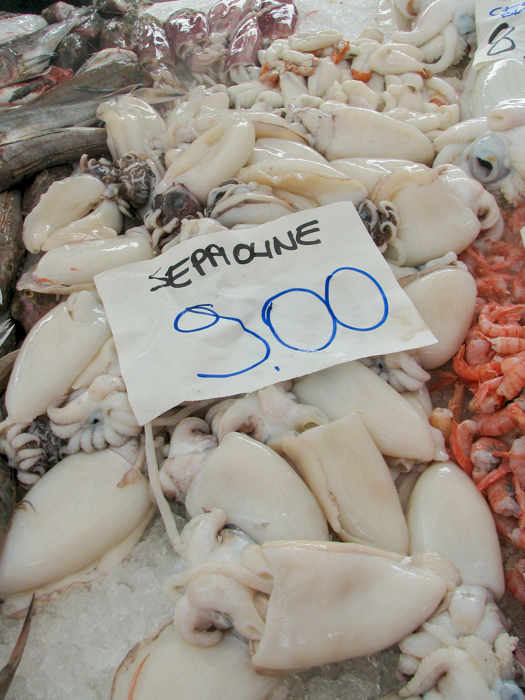
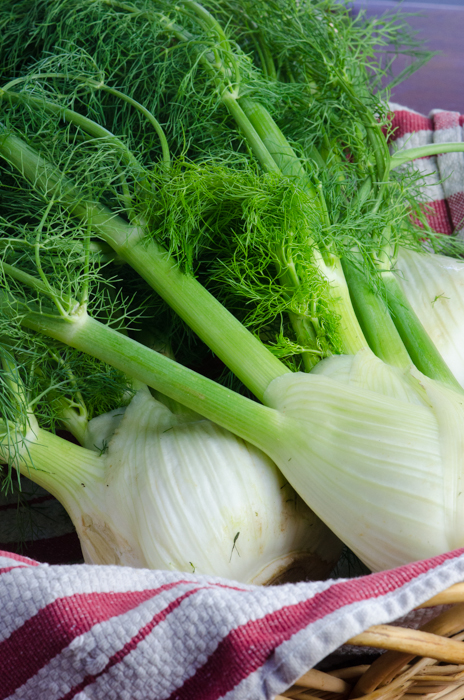 Fennel is a hardy, perennial herb that is indigenous to the shores of the Mediterranean, but today is found many parts of the world, especially on dry soils near the sea-coast and on riverbanks. Known as the Florence fennel, it has a bulb as its base, with stalks emerging from the soil, carrying yellow flowers and distinctive feathery leaves. It has a mild anise-like flavor, but is more aromatic and sweeter. In Italian, fennel is finocchio. Fennel features prominently in Italian cuisine, where bulbs and fronds are used, both raw and cooked, in side dishes, salads, pastas, vegetable dishes and risottos. I particularly like it paired with seafood. Another variation would be to replace the squid with pan-seared scallops.
Fennel is a hardy, perennial herb that is indigenous to the shores of the Mediterranean, but today is found many parts of the world, especially on dry soils near the sea-coast and on riverbanks. Known as the Florence fennel, it has a bulb as its base, with stalks emerging from the soil, carrying yellow flowers and distinctive feathery leaves. It has a mild anise-like flavor, but is more aromatic and sweeter. In Italian, fennel is finocchio. Fennel features prominently in Italian cuisine, where bulbs and fronds are used, both raw and cooked, in side dishes, salads, pastas, vegetable dishes and risottos. I particularly like it paired with seafood. Another variation would be to replace the squid with pan-seared scallops.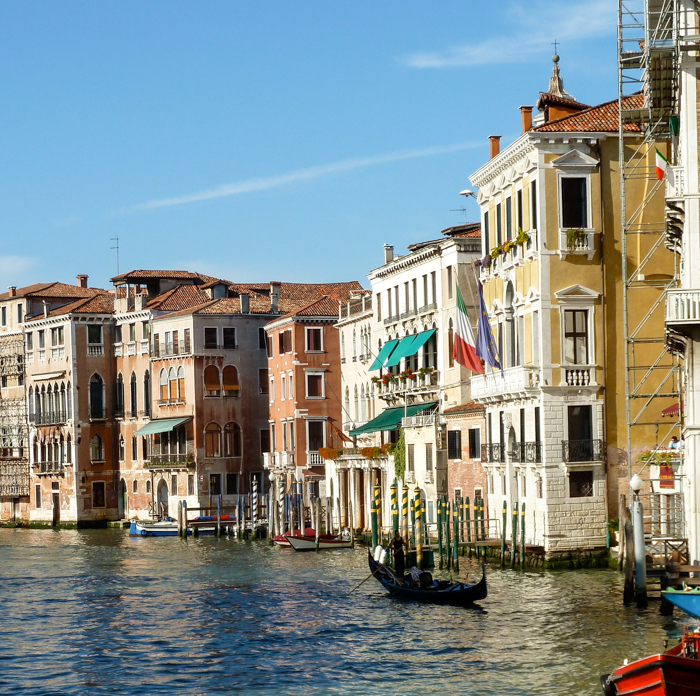 Seppie Aromatizzate al Finocchio – Squid with Fennel Cream
Seppie Aromatizzate al Finocchio – Squid with Fennel Cream